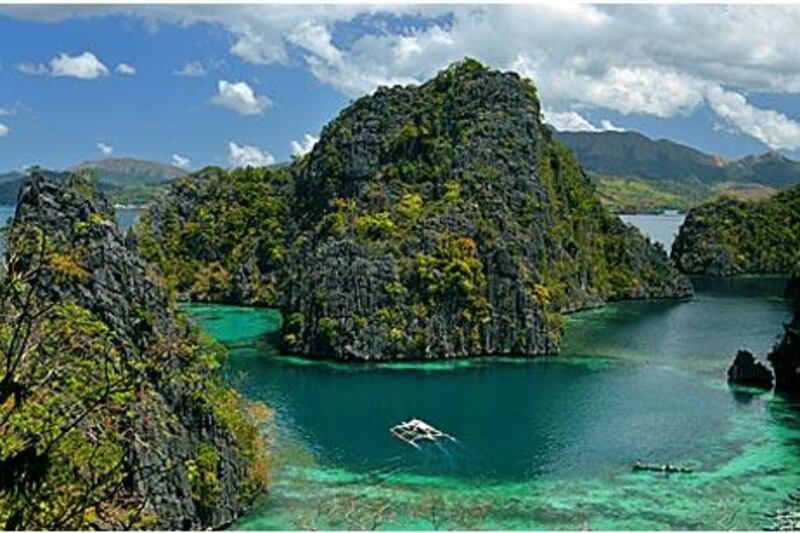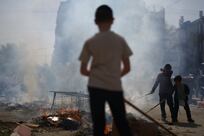It arrived unannounced. Materialising out of the deep blue, it glided towards us and circled once, unsure of this human presence. Slow and graceless on land, the endangered green turtle appeared to be flying through the air in the clear blue water. It disappeared as suddenly as it had appeared, soaring to the surface for air. The sylvan spread of Palawan's mountainous landscape often catches visitors by surprise. Manila, the capital of the Philippines, is flat, sultry and chaotic, the quintessential Asian metropolis. Palawan is hilly, breezy and almost entirely isolated; speeding towards the islands on a speedboat manned by two, cutting a solitary line of foam and spray, we felt like the only spectators to the mountains that loomed large on the horizon, sitting on miles of islands dotting the crystal sea. Yet Palawan's greatest draw resides under the sea. It has been protected by the government since 1967, and there are restrictions on fishing around all but a handful of Palawan's 1,800 islands. The region has many national marine parks, including the Tubbataha Reef Marine Park, a Unesco world heritage site, the Coron Reefs to the north and the El Nido Marine Reserve Park further south.
Here in the Philippines' largest but still relatively unexplored province, divers can see close to 1,200 species of fish by traversing the 2,000km of coastline; the Great Barrier Reef, by contrast, is home to over 1,500 species spread over 2,600km. Some divers, like Dirk Fahrenbach, choose not to leave. A 46-year-old German who has dived and taught in places as varied as Switzerland, Jamaica and the Maldives, the Professional Association of Diving Instructors (Padi) and Scuba Schools Instructor (SSI) certified instructor is also a technical diver and started the Dugong Dive Centre nine years ago.
Named after the marine mammals that frequent the island, one of the few places in the world where sightings are possible, the centre is part of Club Paradise, an eco-resort popular with divers and tourists including travellers from the Middle East who enjoy the stretches of private beach and the option of being served by women only. The resort is situated on its own island, Dimakya, at the north-east tip of Palawan, and is part of the Mindoro group of islands that connects the Sulu Sea with the South China Sea. Lessons are conducted in a mix of classroom and swimming pool settings and sea dives. My partner and I signed up for the Scuba Diving International (SDI) Open Water Scuba Diver certification, a three-day course for beginners.
Diving involves the use of several pieces of equipment in addition to the mask, fins and goggles - the buoyancy control device (BCD), which is an inflatable vest, the weight belt that straps on to the BCD, the regulator through which divers breathe, the octopus or alternate air source, the cylinder that contains compressed oxygen and a host of other appendages that do everything from tell you how deep you are to how much air you have in your tank. Our first lesson involved watching demonstrations of the equipment. Favouring practice over theory, I was eager to get into the pool.
My first confined water class went quite contrary to how I expected. After a couple of botched attempts at learning how to clear my mask when it filled with water, simple enough given that it involved a slight tilt of the glasses and an exhalation through the nostrils to force the water out, Fahrenbach asked me if I'd had any unsavoury experiences with water before. I had, almost drowning in a pool once. He suggested a few deep breaths. "Besides," he said by way of reassurance, "diving accidents are a rare occurrence underwater."
As it turns out, there is little that can go wrong when a diver is underwater. Students learn about every worst-case scenario there is, which can seem daunting, but in reality even a few hours of basic training will safeguard most divers from the danger of running out of air. The risk of faulty equipment is another concern, but this is minimised by learning the importance of double-and triple-checking your partner's equipment before a dive (all divers, even highly experienced ones, are discouraged from diving alone). Additionally, emergency air-sharing procedures are possibly the most practised of all.
Still slightly nervous, I suited up and hauled my equipment to the beach for the first dive. Fahrenbach ran through the basics with us. "Whatever you do, don't forget to breathe," he said. Holding breath underwater causes the air in the lungs to expand, putting divers at risk of lung expansion injury. Putting our masks and goggles on, we began our descent. It was like slipping into a cocoon: warm and silent. The sea opened up around me. Drops of water leaked into my goggles; I cleared them effortlessly. I experienced weightlessness, and there was life here unlike any I had seen. The House reef is home to hundreds of species of marine life. We saw cuttlefish and giant clams, an endangered species. A nest of orange- and white-striped clownfish nearby was inhabited by a family of four. Indigo starfish dotted the ocean floor.
That was when we saw the turtle. Startled by its beauty, I wanted more, but it was time to resurface. It's rare for divers to see the variety of life we had just experienced on their first dive, but I'd been lucky in my choice of destination. Within close vicinity of Dimakya Island alone, divers can choose between two extensive reefs, 11 shipwrecks, the infamous Barracuda Lake, the Tara Islands famous for soft corals, a large natural park and dugong watching.
The first dive was followed by more classroom lessons. We learnt how to inflate and deflate the BCD - important considering the right amount of buoyancy marks the difference between being properly weighted and stable or rising too fast and risking injury. We went over basic procedures like mask clearing and checking each others' equipment before dives. I feared diving, like driving, would be fraught with technicality and I worried that I'd forget how to do something crucial when underwater. I was pleased to find that diving is more about learning how to do a few things thoroughly as opposed to many things at once. Students often find at the end of the course that they've practised the procedures so often they feel they could do them in their sleep.
Our ratio of two students to an instructor lent an air of camaraderie and lessons were peppered with diving anecdotes and instructors dropping by to share stories. Another pool session on the following day involved practising techniques to combat almost every underwater crisis imaginable, from running out of air to towing an exhausted diver back to safety. We learnt that the main thing to remember in an underwater emergency is to stay calm. With the final instructions, we were free to enjoy the rest of the dives.
Each dive revealed more life. Healthy corals resemble a vast urban metropolis with an abundance of marine activity. I saw surgeonfish, large sea cucumbers and in a rare moment, was allowed to touch the flesh of a giant clam. I saw something shadowy on the sea bed; looking closer, it turned out to be a giant moray eel, black and yellow like a bumblebee. A fingered dragonet lay on the seabed, perfectly camouflaged to look like the sand. A blue spotted stingray swam by, oblivious to our presence. Fish representing every colour of the chromatic spectrum hunted for food, made nests and congregated in large shoals. Nearby, a large octopus stayed close to the seabed, rapidly changing colours.
The day ended with a written exam, easy considering the multiple choice format. We celebrated our new status as qualified divers at the bar with the instructors. I saw the green turtle again on my last dive. It looked bigger this time. It made a beeline for us and hovered on the seabed, as though waiting for something. I watched as my instructor sifted through the sand and came up with fistfuls of green seaweed that the turtle devoured. This wasn't the same turtle I saw on the first dive. Nicknamed "Crazy Turtle" by the staff, the 50-year-old was surprisingly comfortable with humans and liked having its shell scratched and being fed. It spent about 20 minutes with us before gliding away to greener pastures.
travel@thenational.ae





